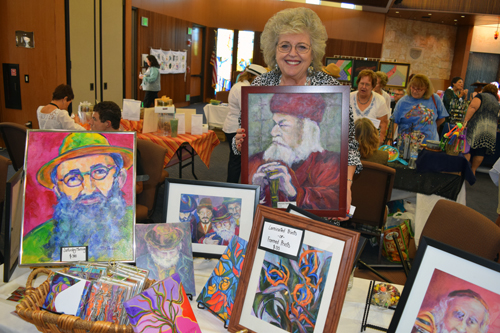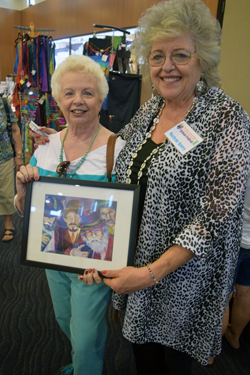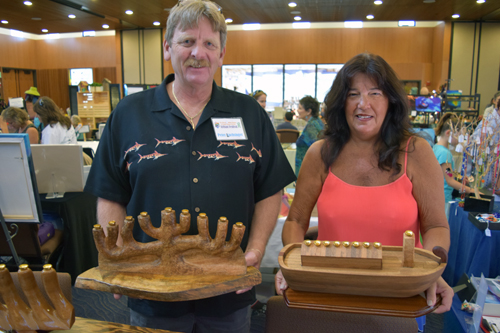
By Donald H. Harrison


SAN DIEGO – At Temple Emanu-El’s annual artisans’ festival, I met a painter who is a member of one of San Diego’s longstanding and well-known Jewish families, and a woodworking craftsman who just recently moved here from Kona, Hawaii, where thanks to his Jewish wife he discovered the joy of Judaica.
The acrylic painter was Marlene Parker Korey, who sometimes goes by her maiden name of “Kolender.” Like her brother, the late Sheriff and former San Diego Police Chief Bill Kolender, Korey has a remarkably quick and self-deprecating sense of humor.
She likes to paint the faces of rabbis–not actual portraits—but the rabbis she sees in her imagination, all of them “scholarly, wise, and comforting.” In answer to a question about whether she has her own studio, she responded: “It would be nice to say that, but I share my space with a washing machine and a dryer. That’s not very inspirational, I will tell you that.”
Couldn’t the vibrations from the machines cause her brush strokes to become wobbly?
“I don’t sit on the washing machine when I paint!” came her rejoinder. “Although that could be interesting.”
She doesn’t do portraits because she prefers more impressionistic painting, utilizing bright colors and conveying the spirits of her subjects rather than their exact dimensions. “When you do a portrait of somebody,” she said, “they are going to say, ‘oh, the nose is too long,’ or ‘the ears are too big,’ or ‘the chin isn’t right and the eyes aren’t either’ so I don’t do commissions. If my rabbis are going to come out with purple hair and an orange and pink face, they probably would not like that.”
She did do a portrait once. It was of her current husband, Arnold Korey, to whom she has been married about ten years. (Her first husband had died of a heart attack at an early age). After the portrait was finished, the grandchildren came over “and they were scared—they said ‘it looks like Grandpa.’ Nu, so who is it supposed to look like? But that is the only picture that I have done of anybody that really looks like the person…. I tried to sell that painting for $1,000 and so far nobody has bought it, and I offered to give them Arnold with it. I told him that he’d play golf with them three times a week, and that he washes dishes, and he helps clean the house, but it still didn’t sell.”
Interviewing Marlene Korey is fun and it is easy to go off on tangents, but I returned to the subject of the rabbis. How did she start developing them as a specialty?
About 20 years ago, she replied, “a friend had given me this laminated place mat, and it had very small pictures of rabbis. They all had different expressions on their faces, and beards, and there is something about the wisdom, education, the safe feeling that you get with rabbis… and then it just started in a class that I took.”
Sometimes she works with photographs, but more often “I do my own drawings.” She had been drawing since she was a child… “Then when my son was 2 years old – he is now 48 – my late husband (Mr. Parker) asked me what I wanted for Mother’s Day. I said an oil painting kit, and since then I’ve gone from oil to acrylics because I didn’t have the patience to wait for oils to dry. At that time too, I smoked, and I was sure that I was going to blow up the house – another reason not to smoke!! – so no turpentine for me, just water with the acrylics, and I have been painting ever since.”
She said that so far her paintings have been purchased by private collectors, and she occasionally suspected some of them may have been more motivated by the fact that Bill Kolender was her older brother than by love of her painting. About Bill, whose recent death was the subject of a nasty article in the San Diego Reader to the effect that he fixed tickets for friends, and kept members of the Copley family (former publishers of the Union-Tribune) out of trouble, Korey declared: “He never fixed my tickets! Write that down! I had a ticket because there was a big tree in front of the sign that said ‘Do not park’ and they gave me a ticket, and I asked Bill, ‘can you help me?” and he said “screw it, just pay the $25!’ and I said ‘Aren’t you going to fix it?’ and he says ‘No!’ …and then I read 50 years later that he supposedly fixed everyone’s ticket but mine – what kind of a brother is that?!”
I pointed out to Korey that I was drawn to her paintings and had asked to interview her before she revealed to me that she was Bill’s sister.
“Write that down too! Write that down.”
*


The woodworker whose work also appealed to me was Peter Luchsinger, who had a collection of menorahs and channukiot among other items for sale. He told me that he is of Swiss background, but that his wife Joyce is Jewish, and that she was the one who turned him onto Judaica.
They had met and married in Los Angeles, lived briefly in Valley Center in northern San Diego County, then moved to Kona, Hawaii, and just last year followed their two sons, ages 24 and 21, back to San Diego County Peter and Joyce now have a home in the Scripps Ranch neighborhood of San Diego.
In Kona, there is a crafts fair once a month, and Luchsinger learned very quickly that while there were few Jews in Kona, there were numerous Jewish tourists who were drawn to menorahs made in such locally grown Hawaiian woods as monkeypod, eucalyptus, jacaranda, and mango.
He and Joyce displayed three pieces for me. One was a Noah’s Ark; another was a Tree of Life, and the third was what he called a design for “oil vessels.” He explained that although it had places for nine oil-holders, he couldn’t really call it a “chanukiah,” because according to tradition, eight of the candles of the chanukiah are supposed to be at the same height, with only the shamash at a different height.
Well, all right, then.
The Noah’s Ark was an improvement on one he previously had made at the request of a school principal who wanted to present it to a bar mitzvah boy. In that the boy chanted from the parasha “Noach,” it seemed a most suitable gift. “This one is made from eucalyptus that I brought from Kona, but it was the same size as the other one.”
Did he really pack up wood and bring it to San Diego with him?
He responded that he and his wife shipped their belongings in a 40-foot container, and that there was sufficient room for the wood, which he had been drying. He now keeps the wood at his “KonaPete Studio” on Miramar Road, and if he should ever run out, he said, he will return to Hawaii to get more because he likes how soft and malleable the wood is.
A second piece, “The Tree of Life,” was crafted from “spalted” mango. When I admitted I had no idea what “spalted” was, he explained, “you let the wood age after you cut it down. It is still wet, and you don’t go into the drying process right away. Organisms try to break down the wood into mulch, so you let them do it just long enough so that it adds color and designs to the wood. Then you stop it, and you dry it, which kills the organisms, and it leaves a lot of different coloring and lines. It brings out a lot of things in the wood.”
Luchsinger told me he usually works with a lathe and such basic tools as a band saw, table saw, and a drill press, but occasionally he will carve the old fashioned way, with a knife. In addition to Judaica, he produces wine glasses and bowls.
Because there are several steps to the woodworking process, including gluing and drying, Luchsinger said he typically has several projects in the works at the same time. When one piece is drying, he is working on another. So producing a specialized wood creation, he said, can take from three to five days.
Retired from working in construction and helping his now also retired wife in the selling of drip irrigation systems (most of them imported from Israel), Luchsinger told me that, as of yet, wood working is more a hobby than a business, although he hopes that with exposure his pieces will become sought after.
“I am not so much concerned with people buying things for art to just look at,” he said. “This is wood and to me wood is something that you should touch and feel and have involved in your life. I like making things that people can use, something as simple as a Kleenex box cover!”
*
Harrison is editor of San Diego Jewish World. He may be contacted via donald.harrison@sdjewishworld.com. More works of the two exhibitors featured in this article may be found on their websites, respectively http://marlenekolenderkorey.com/ and www.konapete.com